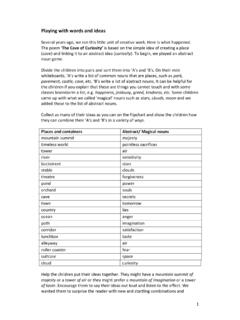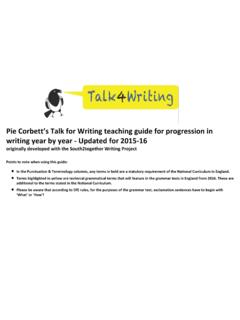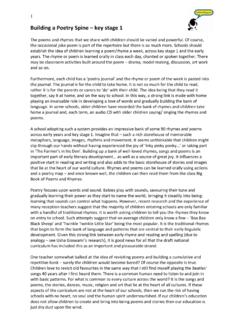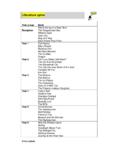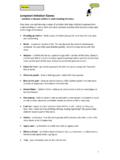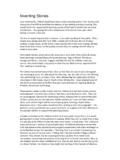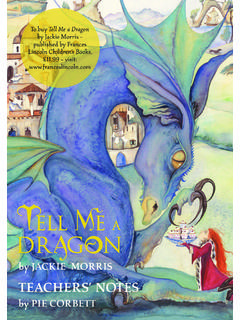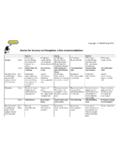Transcription of Story Reading into Writing - Talk for Writing
1 1 Story Reading into Writing Children who read plenty of memorable stories avidly and repetitively, or are read a regular bedtime Story , will implicitly internalise language patterns. Many of these children have the skill to draw on this resource for their own Writing . Traditional tales are significant because they loiter in the mind powerfully due to their rhythmic, repetitive language but also because of their powerful images wolves and trolls tend to hang around! Ted Hughes felt such tales were crucial because they offered blueprints for the imagination . Internalising language and ideas by drawing on Reading can be made increasingly explicit in school. I suspect that all writers develop the habit of Reading with a writerly eye and a writer s curiosity, wondering, how did the author do that? With children, it helps Because in a minute, we are going to attempt the same sort of In this sense, it is Reading with a view to drawing on the approaches of different writers.
2 This aspect of learning to write is one that many writers instinctively know about because their advice to young writers is inevitably, If you want to write then read, read, read . Reading with a writer s eye can help to deepen understanding of how language has been crafted to create different effects a writer s knowledge . The idea that Reading as a writer becomes a form of copying and therefore cheating may be a barrier for some children. In fact, the imitating of sentence patterns gradually adds to the child s linguistic store and later on they often use similar patterns and approaches in their own ways. For instance, a young child might reuse an opening sentence borrowed directly from a telling of The Little Red Hen such as, Once upon a time there was a Little Red Hen who lived on a farm . Later in their Writing the syntactical pattern may reappear, Once upon a time there was a boy called Frostie who lived by a cave.
3 This ability to internalise patterns and use them to create new utterances is how language develops. It is often referred to as generative grammar which is the child s ability to work out the underlying grammatical patterns of a language and then use them to create new utterances. This only happens when a child understands the meaning of what is being said so time spent on deepening understanding and appreciation of texts is crucial if the Reading is to influence the Writing . Instinctively, Maisie, 10 years, knows that the meaning matters when she says, When I am Reading and don t understand a word, I check what it means. We got told to try and put tricky words into a new sentence, then we will remember it and what it means. Once we know it we can always use it. The sort of attentive Reading that consciously looks at the crafting of Writing can help children see how other writers have handled narrative.
4 It is especially useful when considering something difficult that a child would like to attempt. Of course such attentive Reading also helps the reader to internalise the patterns. Where the Writing is especially effective, it may also trigger the imagination. It acts like a catalyst. Good Writing makes you want to write yourself and provides an imaginative store of possibilities that can be drawn upon and extended. As Hursley Moss, 9 years, says, 'If I'm Writing about dragons or mythical creatures, I use my imagination. Handout 2 But, if I was Writing about a fugitive or someone being shot at, I'd get my inspiration from Anthony Horowitz Alex Rider stories . Children who read deeply and attentively live within the imagined world of a Story . When they write, this can be drawn upon and creatively manipulated providing the young reader with a sort of living library of characters, places, events and Writing ideas.
5 So, deep Reading feeds the imaginative storehouse. Alexander is aware of the influence of his Reading , When I am Writing , I sometimes use phrases and wonderful words from books and also from the word board. It helps me to know what to do in Writing . Books by Lemony Snicket are full of good phrases and words to use in any Writing . Obviously, his class have benefited from gathering words and phrases onto a word board . In the same class, Zak not only uses his Reading but also involves his talk partner in discussing possible choices, When I am Writing , I sometimes use the ideas that I have read in books. They give me strong words or even openers. Sometimes I get my ideas from my Talk Partner because they might know better words. Callum is aware of recycling his vocabulary in different stories and knows that every take does not have to be totally new, When I am Writing , I sometimes use strange words and phrases that I have remembered from different books.
6 I also use WOW words that I have used before and I pinch words from my Talk Partner. It is worth pointing out that words in themselves have no value until they are used within a sentence. Lists of words decided upon by the teacher as being effective may lead into formulaic Writing where a child misuses a word and adds it in without really thinking about the effect. This is not Writing . Demi, 10 years, understands the importance of the word choice when he says, When I m Writing , I sometimes use words that I have read in a book. Some people say it is cheating but in English you are allowed to as long as it is good. Where teachers work with children to gather words and sentences, experimenting with vocabulary and thinking about the effects being created, word hoards and word searching can become an important part of becoming a writer. Mason, 10 years, not only borrows words from books but has another technique for making his dialogue realistic, I usually pinch ideas from books that I have read in the past and attempt to use them in my Writing .
7 I also listen to adults speaking in their conversations and try to put them in my work as well. Of course, Reading good books also acts as a yardstick so that when you are Writing , and wondering whether what you have written is any good, it is your previous Reading that helps you make that judgement. In schools, we begin by Reading for pleasure, to feed the imagination and then to move on and read more deeply, to dig away at the meaning and deepen understanding. Once that is done once the Story has been discussed, acted, then there may be space to move on and consider the words from a writer s both what makes something effective or what makes something a weak piece of Writing . It is worth remembering that it is easier to spot other people s weaknesses than our own because we are Reading as a reader rather than as the writer. Of course, it is more obvious in music when a musician plays a wrong note.
8 Bum notes are easy to notice. Looking at poor examples can help a writer think about what is needed to communicate more powerfully. When writers in a class read together as writers, they begin to look carefully, Reading more slowly than before, trying to notice what works. How was this magic 3 constructed? The class discuss what works and then move on to trying it out for themselves. In this way, stylistic features can be constantly noticed, referred to, discussed, collected and then imitated until they become an automatic part of the class s repertoire. In the end, this sort of curiosity becomes a habit that children apply when they are Reading independently. Those of us who took degrees or A levels in English are used to coming to a text in critic mode, to consider a Story as a completed object. However, Reading as a writer involves considering how the Story is made as well as the processes that got it there.
9 Let s now consider what can be learned by Reading stories as a writer ? Noticing the Big Patterns First of all, the overall pattern, theme of a text and the Story idea can be explicitly considered. There is a long-standing tradition in identifying different sorts of narrative patterns that are constantly recycled. Christopher Booker in his book Seven Basic Plots demonstrates the similarities between Beowulf and Jaws , both being classic overcoming the monster Story patterns. Many short stories and picture books lend themselves to children drawing the Story map and moving onto drawing a Story mountain, graph or flow chart that shows the key scenes. This helps to unpick the plot pattern. If children then keep a bank of such patterns in a Writing journal, they can be re-used on many occasions. Later on they may begin to blend different patterns together to create new stories.
10 It begins to help children gain a sense of Story architecture. One of the advantages of getting used to sorting out an underlying pattern is that this can be used as a basis for children s own Writing . A flow chart or grid format helps to structure a narrative and for weaker writers even provides paragraphs. So, many stories act as blueprints for the children s own compositions. Of course, for the text to be well and truly internalised, the children have to loiter with it for some time rereading, dramatising, discussing, focussing on aspects until the text has entered the long-term working memory until they almost own the text because they are so familiar with it. This sort of intense engagement influences the Writing . Noticing the big patterns is simple enough in non-fiction where the organisation and structure is usually fairly obvious. Many people probably think that in narrative, it is less easy to identify building blocks in the same way.
